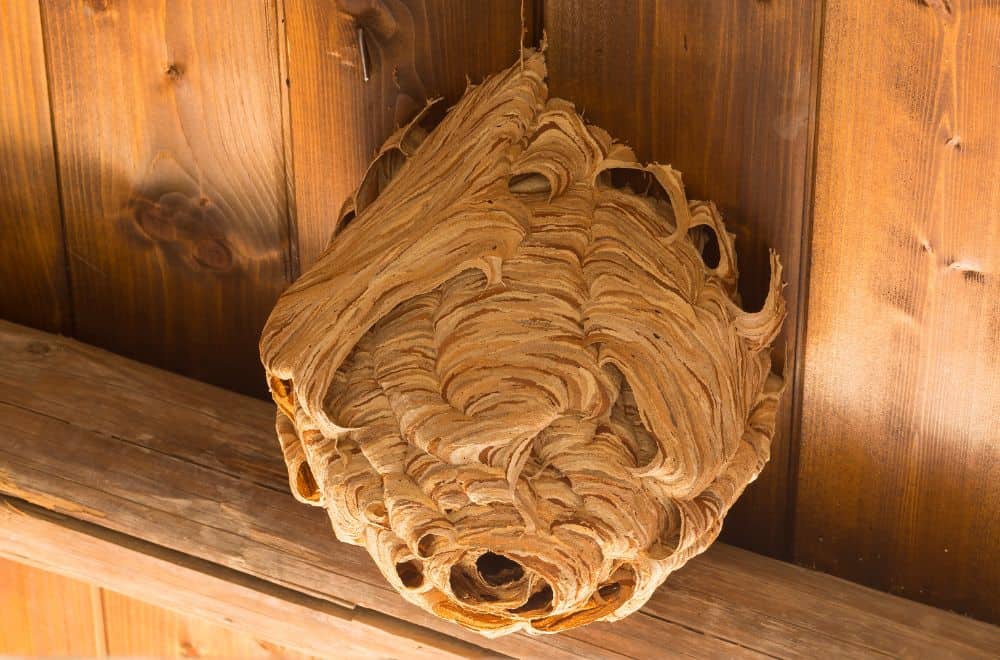Wasps can be terrifying because their stings can be far more painful than bees. And unlike bees, they don’t die immediately after they attack you. Worse, if you squish a wasp after it stings you, its pheromones will attract the rest of its family and they’ll come for you! So let’s learn how to remove wasp nests from your yard using safe, effective, sting-free techniques.
How to Remove Wasp Nests From Your Yard
Step #1: Understand the Wasp Cycle
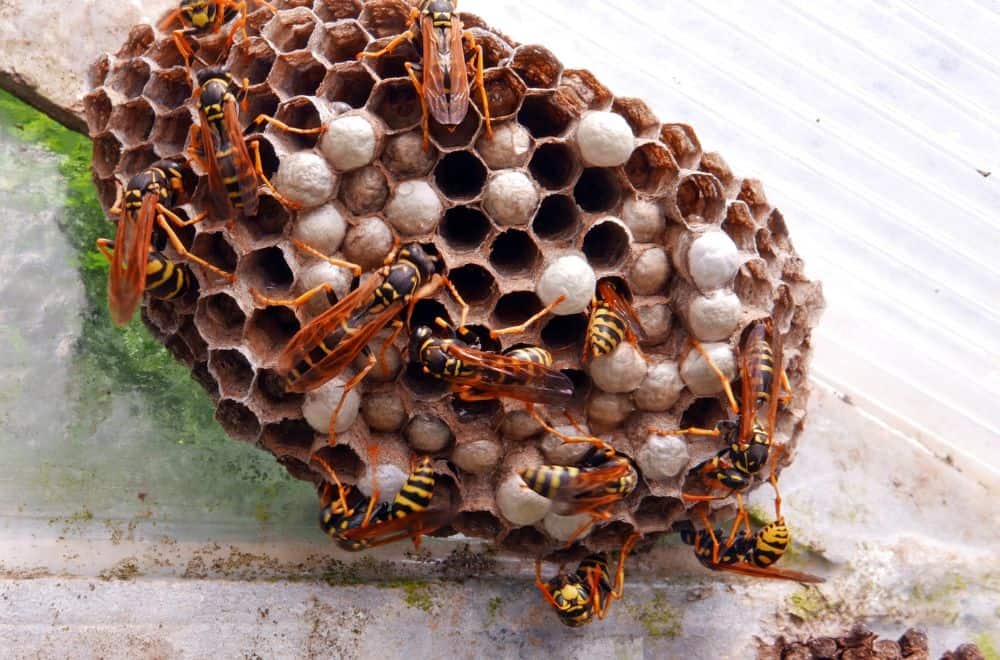
Most wasps are solitary, but some live in colonies where the queen lays all the eggs. A new queen will mate in the fall, hibernate throughout winter, emerge in the spring to lay sterile female worker wasps, then lay new queens and drones. These pairs mate to form colonies, and since new workers aren’t hatching, there’s no one left to defend the existing wasp nest.
Also, one of the most distinctive features of a wasp is its supermodel waist, which can’t digest solid food. So workers hunt and chew protein, give it to the babies, who then produce a clear, energy-dense droplet to feed their babysitters. In winter, the queen isn’t producing eggs so there are no larvae to feed the weak and dying adults. It’s a good time to remove a wasp nest.
Step #2: Identify the Nest Itself
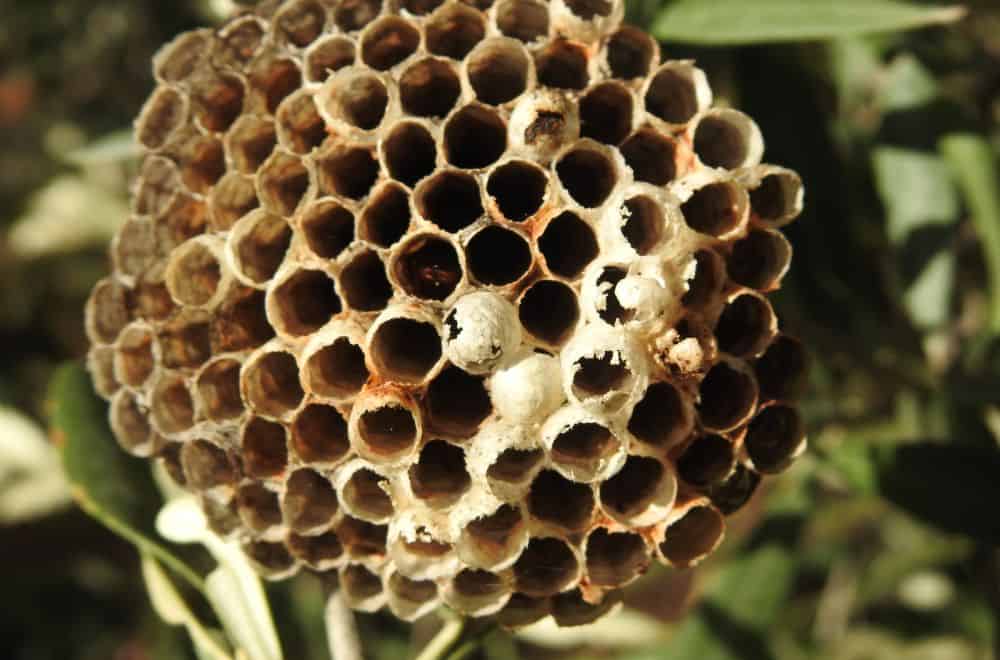
Adult wasps typically eat sugar in the form of honey, nectar, fizzy drinks, honeydew, dessert, and fruits. Colony workers and solitary females only hunt and chew meat when they need to provide food for their larvae. It’s why some solitary females lay eggs in living cockroaches, spiders, and crickets, ensuring their babies have a ready-made food source when they hatch.
For added protection, wasp nests are carefully hidden from predators, so it helps to know what they look like and how to spot them. They resemble honeycomb cocoons wrapped in paper-mâché. Check for them in underground holes, eaves, hollow walls, rotting logs, bird boxes, unused closets, attics, and in the upper corners of sheds, garages, and idle buildings.
Step #3: Rattle the Teen Queen
Once a wasp queen awakes, she’ll scout for the perfect nesting spot, sometimes traveling 40 miles to do it. Then she’ll use cellulose and spit to coil combs, one for each egg she lays. The eggs hatch into larvae in about a week, then molt five times over the next two weeks before they become pupae. After another three weeks, the first workers pop out. That’s 48 days in total.
This isn’t an exact figure, since worker wasps take 28 to 48 days from egg to adult. At that time, the queen is riding solo and her nest is small and weak, so that’s a good time to attack. Other queens will often fight her and try to steal her nest. So if you couldn’t remove the wasp nest over winter, this provides a convenient window to get rid of this budding wasp colony.
Step #4: Try the Garbage Bag Trick
Most nests will only last a year. Once the new queens mate and leave, the drones die. The oldest workers have no more larvae to look after so they abandon the nest. They soon die off because fewer fruits and flowers are available over winter. And since young queens build new nests, they rarely take over used ones. Leaving it intact may be a smart way to deter settlers.
But some old queens do survive the winter and may restart the colony. So while you still have stragglers – or maybe you’re targeting a young queen and her newest babies – wait until they’re in for the night then cover the nest with a trash bag. Pull it down gently and seal the bag shut. Toss it in a garbage can with an airtight light. But don’t try this with an active nest!
Step #5: Cull the Wasps Before Eviction
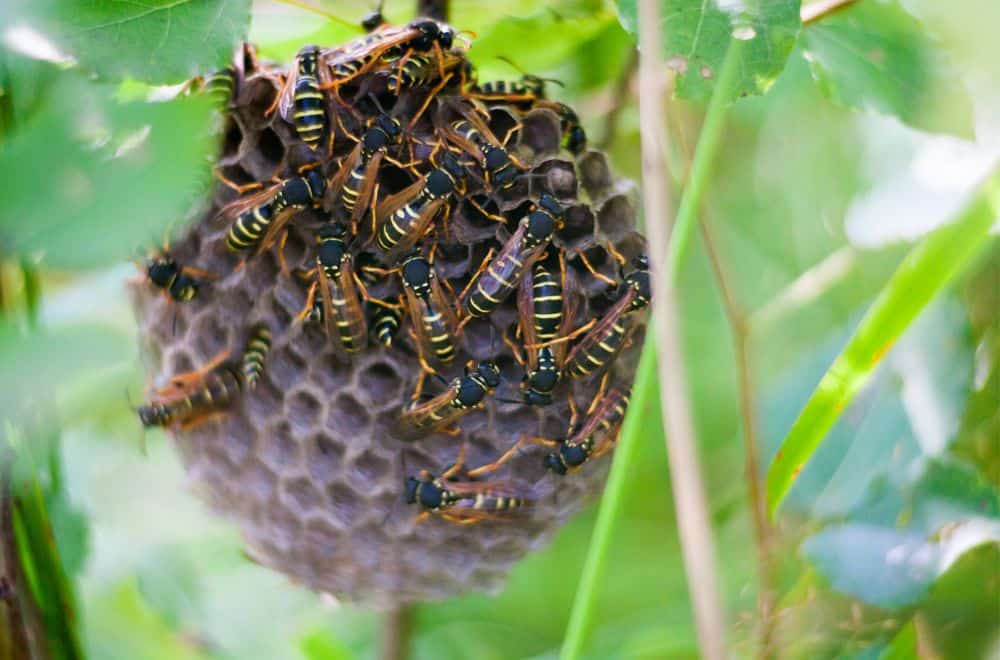
Worker wasps have terrible tempers and are extremely territorial. They’ll even attack drone wasps to stop them from eating and avail more food for their pre-teen queens! (This practice is called male stuffing.) Also, remember, killing one only triggers the others. So never try these tactics on a fully-functional wasp nest. They work best on unfinished or abandoned colonies.
That said, you may be too harassed to wait for winter or spring, so the next few suggestions show you how to remove nests from your yard while they’re active. The trick is to assassinate the wasps before you destroy their home. But you have to choose a killing method that won’t make the dying wasps release the tell-tale hormones that call nearby wasps for vengeance.
Step #6: Spray the Nest Directly
Most wasp species are diurnal, so they start to tire after sunset and spend their nights asleep. When you’re planning how to remove wasp nests from your yard, evenings are best since you still have some daylight and the bugs are less alert. If you wait until it gets dark, you’re more likely to make mistakes and hurt yourself. So as dusk approaches, put on protective gear.
Goggles and gloves will protect your eyes and hands from any toxins. Long sleeves and pants prevent any hyper wasps from targeting exposed skin. Check the wind to be sure nothing blows back into your respiratory passages. Using a recommended wasp spray and standing at a safe spot, cloud the nest with insecticide spray. If any wasps slip out, point at them directly.
Step #7: Make a Soap-Water Spritz
Young Queen Wasps need dry, sunny conditions to build their nests. If it’s too wet or drizzly, the wood-pulp-saliva mixture won’t solidify fast enough to protect the eggs, and the new nest will crumble. Introducing moisture is therefore a great way to destroy a wasp nest. It can be effective with established, occupied wasp nests as well since it suffocates all the residents.
In a spray bottle, mix water with two or more tablespoons of dishwashing liquid. Shake the bottle to form a few bubbles, but it shouldn’t be so foamy that the fluid blocks the nozzles. Stand at a safe distance – ideally with your arms and face covered – and spray the nest. Do it in the evening when the wasps are drowsy. The mixture will clog the insects’ breathing pores.
Step #8: Buy or Build a Trap
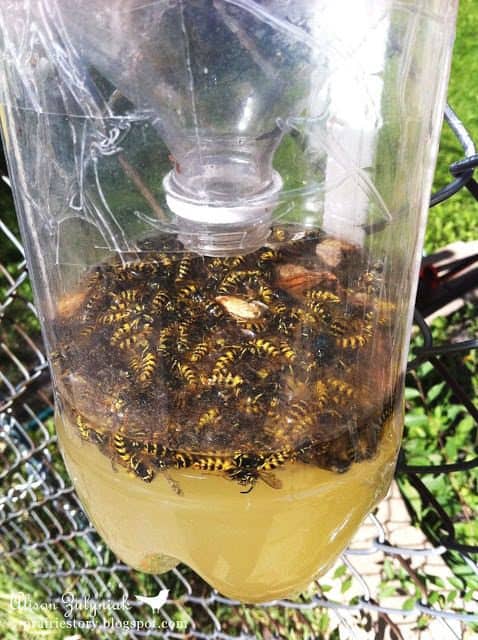
Image Credit: advancepestcontrolbristol
Wasp traps are available (and affordable) at most grocery stores. Look for the hanging kind that’s baited with a sweet sticky liquid that traps and drowns them. Buy several traps and hang them at strategic spots around the nest or the wasps’ food source. You’ll have to change them regularly. They fill up at impressive rates so they get ugly and may attract predators.
Alternatively, you can construct a DIY wasp trap. The easiest option is to poke wasp-sized notches in a soda bottle and bait it with sugar, vinegar, and dishwashing soap. Just like the commercial traps, they’re effective against their targets and the dead wasps may invite other pests to feed on them. So check the trap frequently and empty, refill, or replace it as needed.
Step #9: Eliminate One Wasp at a Time
You may have seen videos where farmers spray individual wasps with that soap-water spritz we mentioned earlier. It’s effective because once the bug’s breathing tubes are blocked, it dies instantly. It also helps that the foamy mixture weighs down their wings in the process. Since you didn’t smush the wasp, it can’t release those dreaded alarm smells, pun intended.
But in the case of an old nest – or maybe a new one with a solo queen and a few workers – you might target one wasp at a time before they have time to multiply. Soapy water is a good trick, and store-bought insecticides can be useful as well. It’s a wasteful technique, but if you only need it for the first (or final) four or five, it works. Just check the direction of the wind.
Step #10: Use Residual Sprays
Soap-water sprays and commercial aerosols typically kill wasps on contact. But you may want to get rid of any unhatched eggs, larvae, or slumbering queens that may still be inside the nest. You might also want to deter any other pests that might become squatters in the nest. As we said, new colonies never form in used or abandoned nests so you might keep it.
But if you do destroy and remove it, other queens might come to rebuild at the same spot if it was favorable. Especially if it still offers shelter from predators and provides accessible food sources e.g. flowers and other pests. A residual spray stays toxic to wasps for weeks or even months, so it can discourage future wasp populations without poisoning the humans around.
Step #11: Block Any Gaps and Cracks
As we mentioned, adult wasps can’t digest solids so they stick to sweet glucose-dense liquids. They can’t find any over winter, so they eventually die out. In the meantime, new queens that mated in the fall will hibernate and wait to lay eggs in the spring. They generally hide in quiet indoor corners before they emerge to build new nests for the eggs that launch new colonies.
These queens often sneak into your household through gaps and cracks so they can hide in your eaves and corners. Then when they wake up, they’ll use cellulose to build fresh nests. By sealing obvious entryways, the young queens can’t shelter in your home or yard so they can’t later use your space as a base for new nests. Instead, they’ll stay exposed to winter predators.
Step #12: Starve Them Out
During the first few months of any colony, all the queen’s eggs hatch into female workers that help her expand the nest. This infertile servant class only lives for three weeks until a new set can mature and take over. Young workers build and babysit, old ones get guard duty, and the mid-workers hunt for protein to feed the babies. If they can’t find any, the nest dies.
By eliminating all food sources, the colony will be forced to move to a place with a steadier supply. Remember, wasp larvae eat protein and excrete sugars which feed the workers and the queen. So keep your sweets covered and get rid of exposed protein sources like carrion, raw pet food, dairy, meat-based trash, insects, and even small animals like birds and reptiles.
Do you know any other ways to remove wasp nests from your yard? Tell us in the comments!
